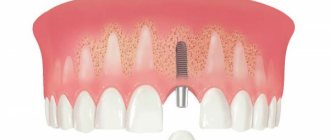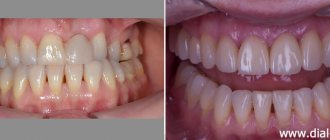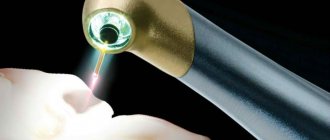In our time, implantology has achieved truly incredible success. Experienced surgeons are able to implant, at a time, not only one tooth root, but an entire row of teeth. Of course, such operations require highly qualified dentists. However, sometimes negative consequences occur after operations, and even during the operations themselves. Less commonly, they occur several years after the seemingly successful implantation of implants into the jawbone. For each such case there are reasons. In this article we will tell you about them.
Why might complications occur?
There may be several reasons for complications after implantation of artificial dental roots. Some of them relate to the mistakes of dentists, and some of them relate to the fault of the patients themselves.
Medical errors include the following:
- incorrect choice of implant length;
- overheating of bone tissue at the site of implant installation;
- insufficient disinfection of the patient’s oral cavity;
- incorrect choice of prosthesis design;
- an error in assessing the physiology of the patient’s body in terms of susceptibility to a foreign body;
- use of low-quality titanium implants;
- use of outdated surgical equipment;
- careless installation of the prosthesis on the root.
The following reasons should be attributed to the fault of the patients themselves:
- careless oral hygiene after implantation;
- the patient's inability to give up bad habits;
- eating solid food during the implant healing stage;
- Irregular use of medications recommended by the surgeon.
For what reason may there be
Installation of implants can be complicated by a number of consequences. Complications may arise due to:
- Medical errors : incompetence of the doctor, incorrect selection of the length of the implant, overheating of tissues during the formation of the hole for the implant, infection, errors in the positioning of the structure, peculiarities of the patient’s physiology, individual intolerance to the implant materials.
- Use of low-quality implants and outdated equipment. A possible disadvantage of the implant may be a poor connection to the abutment.
- Patient's guilt . Most often, failure to maintain sufficient hygiene. The area where the crown touches the gum is especially susceptible to the accumulation of tartar, which causes inflammation. Complications can be caused by failure to follow recommendations for taking medications and lifestyle.
Negative consequences of dental implantation can occur in:
- in the short term - before prosthetics;
- medium-term - within two years after implantation;
- long-term - after two years from the moment of implantation.
- Complete restoration of the dentition in just 4 days!
more detailsRoott Pterygoid Implants Sinus lift is no longer needed!
more details
Once and for life! Express implantation in 4 days with a permanent ReSmile prosthesis
more details
All-on-4, All-on-6, ReSmile, Zygomatic implantation We use all modern methods of dentition restoration
more details
Possible mistakes of surgeons
Negative consequences can occur even during careless operation. Let's name a few medical errors that, unfortunately, although rarely, happen.
Sometimes the doctor inadvertently overheats the head of the titanium root. This occurs due to overheating of the bur and hollow in the jaw bone. The reason for this is untimely irrigation of both.
If the doctor begins to tighten the implant screws while the cement is hardening, this ultimately leads to incorrect root installation, since the cement in this case cracks.
If the doctor does not place the head of the implant tightly in the hollow of the jaw bone, there is a risk of inflammation occurring, as bacteria enter the gap. In addition, loose placement of the head can lead to an imbalance of mechanical load on the entire prosthetic structure. This can cause peri-implantitis.
Question answer:
I don’t have enough bone tissue, they suggested basal implantation. What complications are possible?
Basal implantation is a branch of surgical dentistry, which involves restoring the dentition without replenishing bone tissue deficiency. Implants are installed even if there is a lack of cancellous bone. This reduces the number of necessary surgical procedures and shortens the treatment time, but the method is not confirmed by positive results of long-term data and has many disadvantages: traumatism - elongated titanium rods are used, which are installed in the deep layers of the jaw bone; difficult rehabilitation - long, accompanied by swelling and pain; used when 3 or more teeth are lost - implants are installed at an angle and can damage the roots of adjacent teeth; the service life of implants has not been confirmed; the 2-year rejection rate is about 40%; rejection occurs with exfoliation of bone tissue; low aesthetic result - it is impossible to make dentures that look like natural teeth; limits the possibilities of prosthetics using other methods.
Levin Dmitry Valerievich
Maxillofacial surgeon, chief physician of the Center
Features of implantation in the upper jaw
The operation of implanting titanium roots into the upper jaw is always accompanied by considerable difficulties. This is due to the difficulty of access to the implant installation site and the close location of other organs. Often such operations are accompanied by complications. To make matters worse, the density of the maxillary tissue is lower than that of the mandibular bone. Because of this, it is necessary to drill a deep hole in the bone and install long implants. This can also cause postoperative complications.
During installation of the implant, the nasopalatine bundle, which is located in the center of the upper jaw behind the front teeth, may be injured. Such an injury causes prolonged bleeding, and this leads to the fact that the implant does not take root at all.
There is also a risk of damage to the sinuses and even nasal cavities. In both cases, sad complications are inevitable.
In case of damage to the neurovascular bundles located in the canine area, numbness of the upper lip occurs.
Dentistry knows cases where during implantation the integrity of the sinus floor was violated. This phenomenon leads to the occurrence of sinusitis.
There is also a risk of damage to the palatal artery, causing heavy bleeding.
All of the above may not happen if implantation is performed by experienced surgeons.
Increasing swelling
After installation of the implant, the corresponding part of the face often swells, but after three to five days everything returns to normal. Long-lasting swelling indicates a complication. The cause of the pathological reaction can be:
- developing infection;
- allergic reaction to a titanium implant;
- improper preparation for surgery;
- disruption of the circulatory and lymphatic systems.
You should not try to relieve swelling on your own if it continues to grow. It is better to seek help from a dentist.
Implantation in the lower jaw
Installing artificial roots in the lower jaw is much easier. However, there are certain problems here too, since there are areas on the lower jaw that should never be disturbed.
If during the operation the surgeon disturbs the mandibular branch of the trigeminal nerve, then the patient’s oral cavity will completely lose sensitivity.
If the wall of the mandibular canal is damaged, numbness of the lower lip and part of the chin occurs.
Injury to the external branch of the facial artery generally leads to severe bleeding, and here one cannot do without the help of a surgeon.
Chewing upper teeth
How a tooth is implanted in the upper jaw depends on the individual characteristics of its structure. When it comes to chewing teeth, a two-step technique is often used. In this case, the permanent crown is fixed only after the artificial root has completely taken root in the bone tissue. This method is the most reliable and predictable.
Osteoplastic surgery is a stage that often precedes the implantation of chewing upper teeth. Most experts unanimously choose classic root-shaped structures as artificial roots.
Early complications
In the first days after implantation, the patient may experience pain, sometimes very severe. Often, the dentist even prescribes painkillers to patients, which should never be abused. If the pain does not disappear after a week, this indicates that there is inflammation or nerve damage.
About two hours after implantation, swelling occurs in the patient’s mouth, and this is quite normal. It may not go away for a week. At this time, it is allowed to apply ice to the swollen areas. If after a week the swelling has not subsided, then most likely there is tissue inflammation.
The patient's gums may bleed slightly for two to three days after surgery. Blood oozes at the site of the implanted root. If the bleeding is significant, the cause may be poor blood clotting or high blood pressure. If the bleeding continues, then most likely the surgeon damaged a blood vessel. This, in turn, can cause a hematoma to appear at the implant site. Because of this, postoperative sutures may come apart and the wound may begin to rot.
During the first week after implantation, the patient experiences an elevated body temperature. This is quite normal if the temperature does not exceed 37.5 degrees. If it is higher or does not subside after a week, this means that an inflammatory focus has formed in the oral cavity. This phenomenon is usually accompanied by swelling.
There are cases where in the very first days after surgery, patients’ sutures came apart. This happens due to their careless application, due to mechanical damage from solid food, or due to the onset of inflammation.
If within five hours after the operation there is numbness of the tissues near the oral cavity, then you should not be afraid of this, because the anesthesia has not yet completely worn off. If the numbness continues to persist, then the nerve may have been damaged during implantation.
Recommendations after dental implantation
Statistics on dental implant failure indicate that the main reason for this outcome is the human factor*. Therefore, in order to avoid unnecessary complications, it is necessary to carefully choose the dentist where to place dental implants. It must be equipped with modern equipment, use high-quality implants that meet all standards, whose manufacturers must provide a guarantee in case of implant failure. Implantologists must undergo special training and have experience in performing such operations. Reviews from real patients of the clinics will be a good help in the difficult task of choosing a clinic that meets these criteria. And, of course, do not forget about the basics – regular and high-quality oral hygiene.
All consequences and complications after dental implantation can arise due to the fault of both the doctor and the patient, and sometimes an “X factor” independent of anyone plays a role. It is worth remembering that complications after implantation are still an exception to the rule. Therefore, you should boldly say to this unique technique: “YES!”
*Research data from the international company Nobel Biocare Russia
Late complications
Such complications can arise a year after the successful implantation of artificial roots and the installation of prostheses on them.
Peri-implantitis. Sometimes patients develop peri-implantitis after a year. In simple terms, this is inflammation of the bone tissue near the implant. Most often, the cause of its appearance is careless oral hygiene. Less commonly, the reason is a violation of the implant installation technology. In particular, there are known cases of damage to the gingival cuff and even the presence of cement in it.
It is possible to cure peri-implantitis with medication only at an early stage of its development. In this case, in any case, it is necessary to remove the prosthesis from the root and laser or ultrasonic cleaning of the implant itself. If tartar has formed in the oral cavity, then they must also be removed. Only after this are medications prescribed.
At a later stage of development of peri-implantitis, treatment is much more difficult. It is a complex of surgical and medical procedures. These include:
- ultrasonic sanitation of the oral cavity and gum pockets;
- opening the purulent focus and cleansing the tissue underneath;
- thorough disinfection of the implant;
- removal of dead tissue;
- prescribing a course of drug treatment.
The advanced stage of peri-implantitis cannot be treated. At this stage, the implant becomes mobile. In this case, it has to be removed from the jawbone. A new implant can be installed only after peri-implantitis is completely cured. Unfortunately, this is by no means a simple matter. Only 6 months after the cure of peri-implantitis is osteoplasty allowed, without which re-implantation of the titanium root in the same place is impossible.
Sinusitis. This complication manifests itself in the form of inflammation of the oral mucosa near the maxillary sinus. The treatment process does not require removal of the implant. Usually the problem is solved with drug treatment.
Mechanical damage. Complications due to mechanical damage arise solely through the fault of the patient when, in violation of the doctor’s recommendations, he became interested in eating too much solid food. In addition, mechanical damage to the structure can occur from malocclusion or bruxism. There are known cases where prostheses and even implants broke in such cases. It doesn't matter if the prosthesis breaks. It can be easily replaced. If the implant breaks, then its removal from the jawbone is required.
Treatment
An x-ray allows the dentist to understand exactly what the problem is. Mostly, complications are caused by inflammatory processes. Anti-inflammatory therapy, antiseptic surface treatment, and hygienic care are carried out.
In case of peri-implantitis, inflamed tissue is removed, the pin is cleaned and treated with an antiseptic.
In some cases, complications after dental implantation require removal of the post. For example, if the implant breaks, it is rejected, or treatment of inflammatory processes is not successful.
The implant is removed by carefully twisting it out of the bone, trying to minimize trauma to surrounding tissue.
The issue of re-implantation is considered in each case separately. Most often, a two-stage protocol is impossible without bone grafting. But with the one-step method, you can do without it. In any case, you will have to wait until the inflamed tissues recover. However, it should not be delayed to avoid bone loss.
The decision to re-implant after removal of a dental implant must be made by the doctor. It takes into account all the factors necessary for the success of the operation. If rejection is caused by biological reasons, low immunity, smoking, then the positive result of re-implantation is in doubt and it is better to use alternative prosthetic methods.
Non-survival of the implant
The phenomenon of implant rejection by bone tissue is extremely rare. There is only one way out of the situation - removal of the implants.
Implant rejection does not occur instantly, but in a certain sequence. Each stage of this phenomenon is accompanied by its own symptoms.
At the first stage of rejection, tissue inflammation occurs near the implant. This is followed by an enlargement of the pocket and thinning of the bone in the area of the implant.
In the second stage, the height of the jawbone around the implant noticeably decreases. At the same time, gum detachment occurs until the abutment is exposed. The implant becomes mobile.
The third and final stage is characterized by destruction of the alveolar process and rejection of the implant itself.
The beginning of the implant rejection process can be determined by the following signs:
- swelling of the gums in the area of the implant and next to it;
- general malaise;
- the appearance of pus in the oral cavity;
- the appearance of bleeding from the gums;
- enlargement of the gum pocket;
- implant mobility;
- increase in body temperature.
Dental implant systems with minimal risk
There is a huge variety of implants, differing in many ways.
Dental systems with an impeccable reputation are produced in Switzerland, Germany, and Israel.
To protect yourself as much as possible when choosing implants, you need to consider the following criteria :
- structures must be made of highly purified titanium ;
- the surface of the implant must have macro- and microthreads ;
- the presence of a conical connection between the implant and the abutment;
- lifetime warranty on the system;
- time of existence of the manufacturing company in the dental market.
Safe complications
Even after an impeccably performed implantation, natural complications always occur, which are the body’s natural reaction to mechanical intervention. We list the complications that you do not need to be afraid of:
- body temperature up to 37.5 degrees;
- swelling of the face;
- feeling of heaviness in the maxillary sinus;
- minor hematomas;
- quite tolerable pain.
All these troubles can only be endured for a week. If they do not disappear further, then, most likely, something went wrong during the implant healing process.
How can complications be prevented?
Practice shows that by strictly following all doctor’s recommendations, you can significantly reduce the risk of complications. To do this you need:
- regularly take the medications prescribed by the doctor;
- carefully perform oral hygiene;
- quit smoking;
- undergo annual x-ray diagnostics of the oral cavity;
- stop eating solid food;
- strictly adhere to the postoperative diet.










